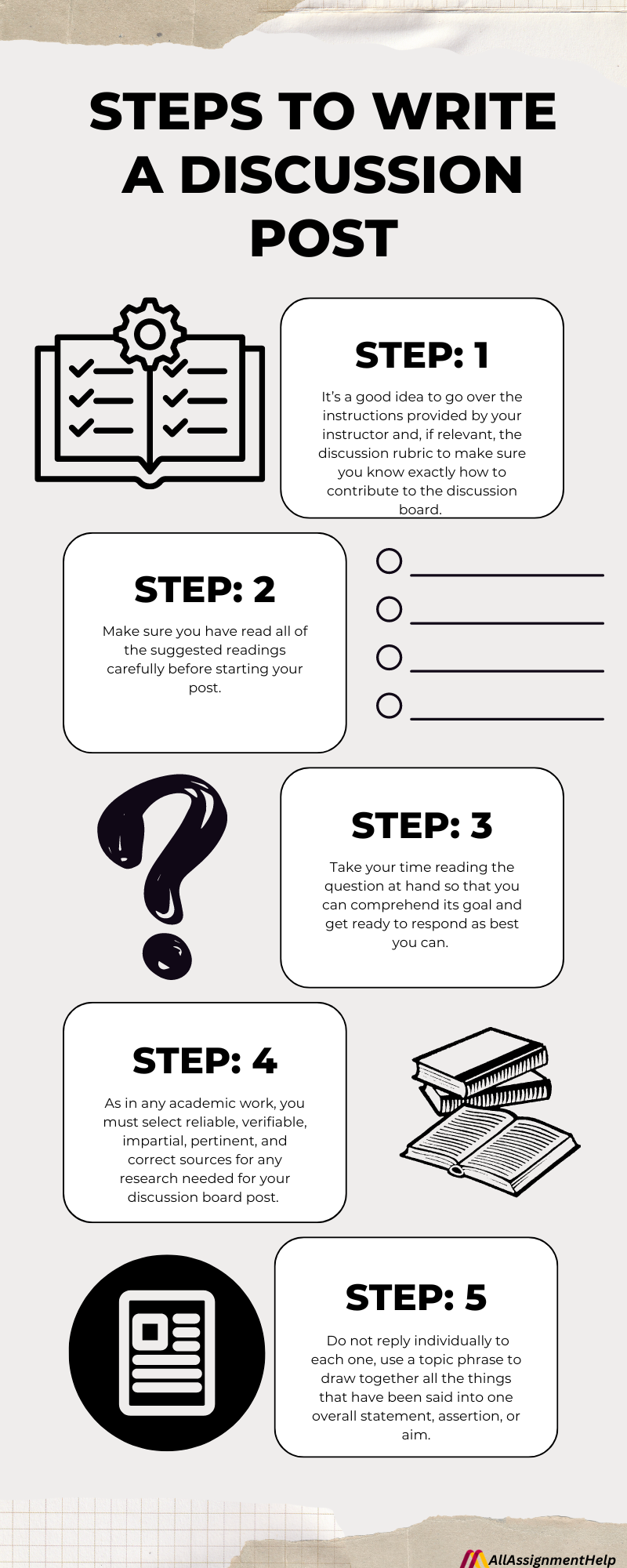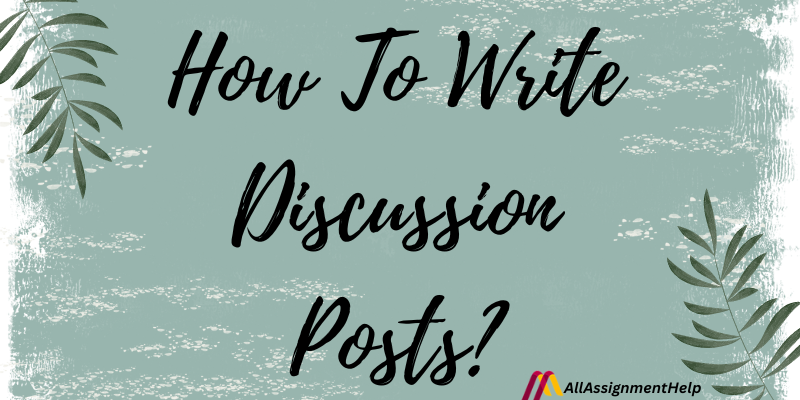Table of Contents
Discussion post is an important part of college courses because they develop a feeling of community and help students strengthen their research, communication, and critical thinking abilities. Teachers can use these useful tools to assess their students’ comprehension of key ideas.
Since they let students participate and communicate with their professors and other students even when not physically present, discussion post interactions are particularly useful in online courses. Students can respond to questions posed by one another and ask new questions or raise ideas that spark further discussion by interacting with one another through discussion posts and responses.
Writing a successful discussion post goes beyond mere participation; it involves fostering meaningful discourse, expressing ideas clearly, and engaging in thoughtful reflection. This blog by experts at AllAssignmentHelp will help you explore how to create an effective discussion post, offering techniques for clearly articulating your thoughts, engaging mindfully with peers, and making a substantial contribution to online discussions.
What Is A Discussion Post?
A discussion board serves as a “space” for students to explore further what has been covered in class. It can encourage teamwork and provide people space to consider various subjects, problems, and/or queries. For those students who would like to communicate their comprehension of the course material in writing rather than spoken, the discussion board is a great resource.
Assignments such as discussion postings are often given to encourage participation, critical thinking, and teamwork among students in the course. They often provide an opportunity for students to participate in ongoing discussions, reflect on assigned readings, and ask questions to connect with the course material or the viewpoints of other students. Students are encouraged to use their information, hone their critical thinking abilities, and engage in deep dialogue with their peers through these kinds of conversations.
How Do You Choose A Topic For A Discussion Board?
A topic for a discussion board should always promote learning. Idealistically, it ought to
- Talk about the course material.
- Explain how you understand the subject matter.
- Encourage cooperation among colleagues.
Steps To Write A Discussion Post
Here are some steps you should follow when composing posts on the discussion boards. To make sure you meet all of the requirements for your assignment, review your course syllabus or speak with your instructor or you can get online assignment help as well if required. They may specify particular requirements that go beyond the fundamental stages listed below.

Steps1: Go over the instructions carefully
It’s a good idea to go over the instructions provided by your instructor and, if relevant, the discussion rubric to make sure you know exactly how to contribute to the discussion board. For instance, it is helpful to be aware of your instructor’s expectations before starting, such as responding to a minimum of two other students’ discussion postings or properly citing your sources.
The word limit for your response, the deadline for your responses, the format requirements, and the kind of research you must undertake before writing your article should all be noted.
Step 2: Make proper preparations
- Make sure you have read all of the suggested readings carefully before starting your post.
- Review the feedback that your teacher has provided on past assignments. What would you like to change about this future post based on the input you received?
- After reading, take some time to write down your thoughts, feelings, and answers to the text.
- By evaluating the strength of your evidence for each assertion, response, or claim, you can identify one or two of your strongest ideas around which to build your response.
- To make your claim both clear and compelling, logically put together a basic overview of your supporting data.
Step 3: Ensure that you understand every question
Take your time reading the question at hand so that you can comprehend its goal and get ready to respond as best you can. Your lecturer may present multi-component, complicated problems depending on the particular class. To make sure you understand what is being asked of you, try asking yourself the same question again in straightforward terms.
Step 4: Do Some Research on Your Subject
As in any academic work, you must select reliable, verifiable, impartial, pertinent, and correct sources for any research needed for your discussion board post. Your instructor should advise you on what kinds of sources to use scholarly, peer-reviewed journals, essays, or other reliable sources.
It may be best to stay away from secondary or less trustworthy sources, including blog entries, which frequently represent the author’s opinion rather than the facts, depending on the specifications of your project.
Step 5: Create a draft
Most of the time, discussion post assignments are a set of questions. Do not reply individually to each one, use a topic phrase to draw together all the things that have been said into one overall statement, assertion, or aim.• Organize your response using your sources and develop your arguments based on the information and the findings that you’ve made, It is pertinent to support your points by referring to the outside sources if allowed or necessary or any other source from the course.
• Ensure that each item that you have chosen supports your post’s scholarly tenor, topic, purpose and communication.
• Make sure that whenever you used information from other sources in your post, that was acknowledged appropriately or all the ideas used were copied from other sources as well and a comprehensive Reference section was provided at the end.
Step 6: Write Your Opinion
Stating that one agrees or disagrees with someone else’s comment is unproductive because it does not elicit a revitalized conversation. Take some time before writing their response to plan on what they are going to write. You should also anticipate every possible conflict or question and complete conceptions about it. It helps you to come up with a sound response especially if you are given ample time to write your response.
If you like, before pasting your response into the discussion board, write your ideas in a Word or Google document. It allows you to write a first, not very polished version of your reply which you can then reread and check whether it is grammatically correct, whether it answers the question reflectively and whether it has been written in a considerate and thoughtful manner.
Step 7: Go over and make revisions
Once you’ve finished writing, go over your thoughts by asking yourself:
- Is my major claim clear and relevant to the topic in question?
- Am I demonstrating that I have read the texts set for this assignment and that I have given the matter some degree of thought?
- Has one launched a novel idea that they could argue come exam time?
- Has the student incorporated the required readings or any other reliable sources to support his/her claims?
- Am I guilty of writing in flats and participating in unnecessary wordiness instead of avoiding the use of complex and plain language?
- Has the grammar, style and order of my response been properly done?
Step 8: Turn in
- Put your completed document into the discussion thread by copying and pasting it.
- Verify briefly that no formatting errors happened throughout the upload process.
- Await your classmates’ responses with patience.
So, these are some important steps to consider while writing a discussion post. If you’re feeling overwhelmed with your coursework and exams, you can even look for expert help by searching for services like, take my online exam for me. This way, you can focus on improving your writing skills without the added pressure of managing multiple tasks. Balancing assignments, exams, and learning how to write effective discussion posts can be challenging, but with the right support, you can stay on top of everything and excel in your academic journey.
Guidelines for a Strong Discussion Board Reply
A well-written discussion board comment should encourage critical thinking, exchange ideas, offer pertinent information, and motivate other members to join in on the discussion. Here are some pointers for crafting impactful discussion board replies.
- Post any elaborative statement for your stance, do not just write ‘I agree/disagree with the poster’. Do not make any personal attacks on the other students and no matter what you should keep your behavior professional at all times.
- As you would in a face-to-face discussion that you have with your peers in a class, ensure your response is thoughtful, empathetic and/or supportive.
- To encourage the conversation go ahead and ask intelligent questions.
- Do not respond with such utterly boring phrases as ‘I agree’ or ‘I disagree.’ Instead, you have to provide the reasons for the disagreement or agreement.
- Ensure that you do not deviate from the topic in your analysis.
- Avoid repetition.
- It is preferred to type short answers instead of long answers.
- If necessary, establish headers and the subject of the certain post regarding its topic.
How To Post On The Blackboard Discussion Board?
The following is a general guide to posting on the Blackboard discussion board:
- Go to homepage
- Click on the discussion forum
- Select “Create Thread.”
- Put your thread’s title here.
- Write your argument in the Entry Message text box.
- Click “Publish, Submit, or Post.”
A crucial component of forums is replying to postings. To reply to a thread, follow these steps:
- Open the thread
- Select on which you want to respond
- Click reply
- Type your message in here. By selecting the Attachment feature, you can attach files if necessary.
- Click Publish to submit
Conclusion
Proficiency in writing discussion posts is a valuable ability that improves both academic success and online communication. You can create entries that are interesting and perceptive by fully grasping the subject, doing extensive research, and logically arranging your ideas. Don’t forget to use evidence to back up your claims, speak courteously, and close with provocative questions or calls to action to spark additional conversation.
You’ll benefit immensely from our discussion post template and advice for your academic career. However, you don’t have to overwork yourself if you don’t have enough free time. If you’ve ever thought, I wish someone could take my online class for me, submit a request to our experts and they’ll do all in their power to fulfil your wish.
FAQs
| How do I begin a comment on a discussion post? First of all, Salutations and appreciation for the work of your peer should open your response. This starts the conversation off on a good note. Body: Discuss certain issues raised in the original post. |
| What does the term “discussion format” mean? Generally speaking, the “Discussion” part can be split into three distinct paragraphs. 1) An introduction; 2) a set of intermediate paragraphs; and 3) a conclusion. The primary concept for carrying out the relevant investigation is presented in the first paragraph. |
